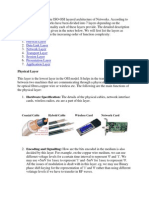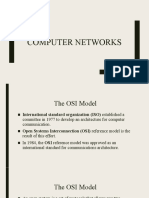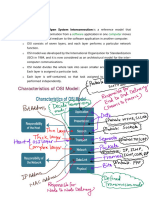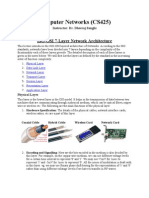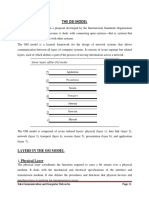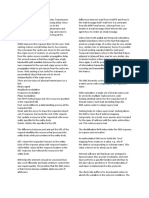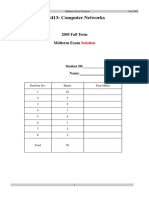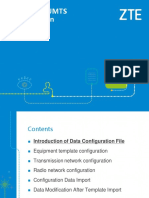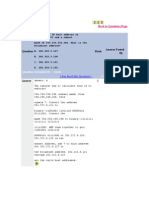Open System Interconnect (OSI) Model:
In 1978 International standard organization introduced a model called open system interconnection.
OSI is not a protocol, it is a model of understanding and network architecture that is flexible robust
and interoperable.
OSI model is built of seven layers.
Seven Layers of OSI
1) Physical layer
2) Data link layer
3) Network layer
4) Transport layer
5) Session layer
6) Presentation layer
7) Application layer
When a message is to be sent from device A to device B this message must pass through these
layers . Figure1 (On the next slide) shows the layer involved when message is sent from device A to
device B
�These layers can be thought of as belonging to three subgroups. Layer 1,2 and 3 i.e. physical data
link and network layer deals with physical aspect of moving data, layer 4 is responsible for end-to-
end data transmission for entire message. Layer 5 6 and 7 that is session presentation and
application can be thought of as user support layers. They allow interoperability among on related
software systems.
Functions of Layers
Physical Layer
�Physical layer is the lowest layer of OSI model. It deals with mechanical and electrical specification of
interface and transmission medium. The physical layer concerned with the following:
1) Physical Characteristics of interface and transmission media .
2) Type of encoding that is which signal pattern represents a binary 1 and which represents a
binary zero
3) The transmission rate that is the number of bits sent/received per second
4) Synchronization of bits. the sender and the receiver must be synchronized at bit level
Data Link Layer
The data link layer provides error free transfer of data frames from the one computer to another
over the physical layer. Data link layer performs the following functions-
Responsibilities of Data Link Layer
a. Framing:
The data link layer divides the stream of BITS received from the upper layer into the manageable
data units called frames.
b. Physical addressing
Frames are to be distributed to different systems on the same network, the data link layer adds a
header to the frame to define physical address of sender and receiver of the frame.
c. Flow control:
if the rate at which the data absorbed by the receiver is not equal to the rate at which the data is
produced at the centre side the data link layer impose is a flow control mechanism to prevent
overwhelming of receiver.
d. Error control:
The data link adds reliability to physical layer by hiding a mechanism to detect and retransmit
damaged or lost frames. It is also useful mechanism to prevent duplication of frames.
e. Access control:
When two or more devices are connected to the same link, data link layer protocols are necessary to
determine which device has control over the link at any given time.
3. Network Layer
❖ The network layer is responsible for source to destination delivery of data packet possibly
across multiple networks.
❖ If two systems are connected to the same network, there is usually no need for network
layer, if two systems are attached to different networks with the connecting device between
them often there is need for network layer to accomplish source to destination delivery.
Specific responsibilities of network layer is as under:
a. Logical addressing:
The physical addressing implemented by Data link layer handles addressing problem locally. Is
packet crosses the network boundary we need another addressing to help distinguish the source and
�destination systems. The network layer ads are headed to the packet coming from the upper layer
that include logical address of sender and receiver.
b. Routing:
if independent networks are connected together to create an internetwork or large network, the
connecting device called routers or gateways route the packet to the final destination.
4.Transport Layer
Responsibilities of Transport Layer
a. Segmentation and Reassembly:
A message is divided into transmittable segments. Each segment contains a sequence number.
These numbers enables the transport layer to reassemble the entire message correctly upon
arriving at the destination and to identify and replace packets that we are lost in the transmission.
b. Connection control:
The transport layer can be either connectionless are connection oriented. Connectionless transport
layer treats each segment as independent packet and delivers it to the destination machine. A
Connection oriented transport layer makes a connection with the transport layer at the destination
machine before delivering the packet. After all the data is transferred the connection is terminated.
c. Error control:
Like data link layer the transport layer is responsible for error control. However error control at this
level is performed end to end rather than across a single link
d. Flow control:
Like the data link layer, the transport layer is responsible for flow control. However flow control at
this level is performed end to end rather than across a single link
5. Session Layer
The services provided by the first three layers (physical, data link and network) are not sufficient for
some processes. Session layer is network dialogue controller. It is establishes maintains and
synchronizes the interaction between the communication system.
Specific responsibilities of session layer include the following:
a. Dialog Control:
The session layer allows two systems to enter into dialogue. it allowed the communication between
two processes to take place either in half duplex or full duplex mode.
b. Synchronization:
The session layer allows a process to add checkpoints (synchronization points) into the stream of
data for example if the system is sending a file of two thousand pages it is advisable to insert
checkpoints after every hundred pages to ensure that hundred page unit received and
acknowledged independently.
Presentation Layer
�Presentation Layer is concerned with the syntax and the semantics of information exchange
between two systems.
Specific responsibilities of presentation layer include the following
a. Translation
The processes in the two systems are usually exchanging information in the form of character strings
numbers and so on. The information should be changed to bit stream before being transmitted.
because different computers use different encoding systems, the presentation layer is responsible
for interoperability between these different encoding methods the presentation layer at the
sender's side changes the information from sender dependent format to a common format
b. Encryption
To carry sensitive information a system must be able to achieve privacy. the sender transforms the
original information to another form and sender the resulting information out over the network.
c. Compression
Data compression reduces the number of bits to be transmitted data compression becomes
particularly important in transmission of multimedia such as text audio and videos.
Application Layer
Application layer enables the user to access the network. It provides user interface and support for
services such as electronic mail, remote file access transfer and management remote database
management and another type of distributed information source services.
Specific services provided by the application layer include the following
a. Network virtual terminal
Network virtual terminal is a software version of physical terminal and allows a user to login to a
remote host the user computer talks to the software terminal which in turn talks to the host and
vice versa
b.File Transfer access and Management
This application allows a user to access a file in a remote computer, to retrieve file from remote
computer and to manage file in remote computer
c.Mail service
This application provides the basis for email forwarding and storage
d.Directory services
This application provides distributed database source and access for global Information about
various objects and services.








